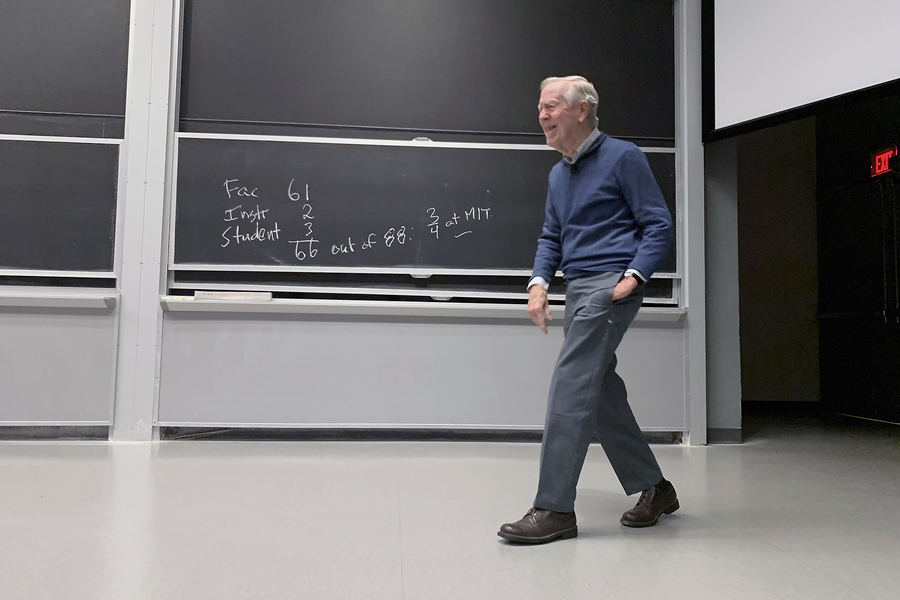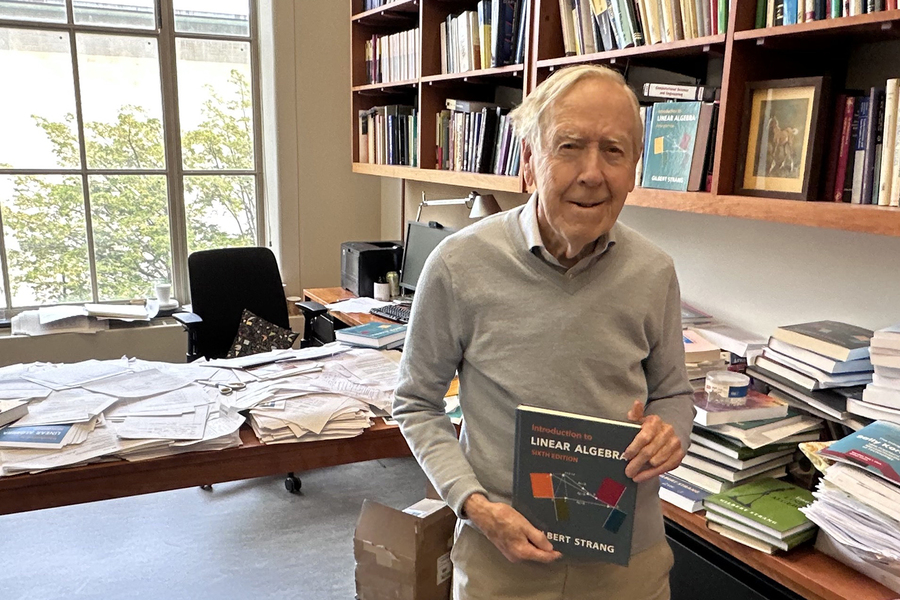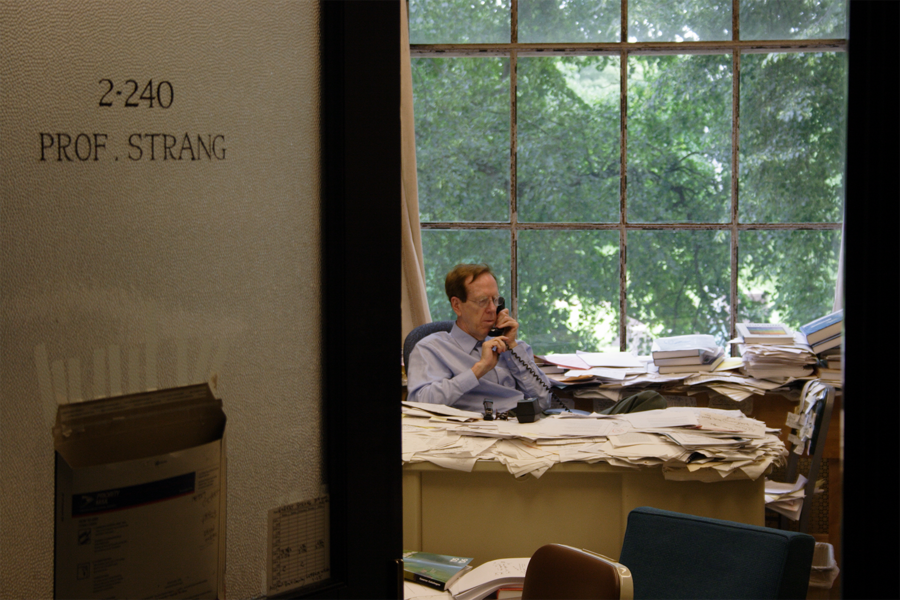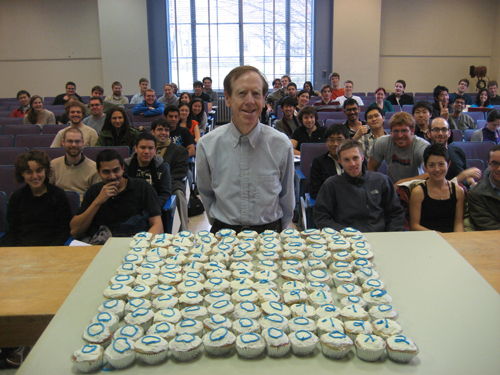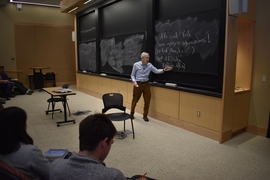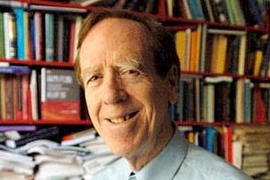The following series of numbers might help to summarize the MIT career of MathWorks Professor of Mathematics Gilbert “Gil” Strang ’55, who taught his last class on May 15.
3+2+61=66, or 75% of his life
Strang has spent 66 of his 88 years at MIT — as a student, an instructor, and a faculty member.
“There were about eight math majors then,” says Strang, a William Barton Rogers Scholar who took just three years to graduate from MIT with a BS, in 1955. “And now there are hundreds.”
Strang received a BA and MA in 1957 as a Rhodes Scholar at Balliol College in Oxford, England, and a PhD in 1959 from the University of California at Los Angeles, where he was advised by Peter Henrici. His dissertation was "Difference Methods for Mixed Boundary Value Problems.”
A CLE Moore instructor from 1959 to 1961, he joined the MIT faculty in 1962. A full professor in 1970, Strang focuses his research on mathematical analysis, linear algebra, and partial differential equations.
“He has had a tremendous impact on the teaching of mathematics to tens of thousands of students at MIT through his lectures, to countless students at other academic institutions through his textbooks, and to millions of people all over the globe through his online lectures and digital media,” says Professor Michel Goemans, head of the Department of Mathematics.
1934
Year in which Strang was born, in Chicago.
His parents William and Mary Catherine Strang emigrated to the United States from Scotland. Strang and his sister Vivian grew up in Washington and Cincinnati, Ohio, and attended the Principia School in St. Louis, Missouri. He and his wife Jillian have three sons, David, John, and Robert, and 10 grandchildren.
15,000
Number of students he has taught at MIT since he was a CLE Moore instructor.
Strang has taught calculus, analysis, and computational science and engineering (18.085). But it’s his linear algebra class that evolved into a course eventually taken by a third of the MIT student body.
Strang began teaching linear algebra in the 1970s, during a time when engineers and scientists wrote large software packages using the finite element method to solve structural problems in mechanics. But he saw the need to restructure the class so he could teach linear algebra in a constructive way, to show that it was related to everything from pure math to the internet. “We needed to explain the ideas in concrete language that students could follow and understand and use,” he explains.
17
Number of awards and recognitions he has received for his research, service, and teaching.
These include the 1976 Chauvenet Prize; the Society for Industrial and Applied Mathematics’ (SIAM’s) 2003 Award for Distinguished Service; and the 2020 Irwin Sizer Award for the Most Significant Improvement to MIT Education.
Strang also won the Graduate School Teaching Award in 2003; the Von Neumann Prize Medal of the U.S. Association for Computational Mechanics in 2005; the Mathematical Association of America’s Lester Ford Prize in 2005 and the Haimo Prize in 2006; and the Henrici and Su Buchin Prizes of the International Congress of Industrial & Applied Mathematics in 2007.
He is a member of the National Academy of Sciences, a fellow of the American Academy of Arts and Sciences, and an honorary fellow of Balliol College, Oxford. In 2019, he was elected as a foreign member of the Russian Academy of Sciences, in the section of Applied Mathematics and Computer Science. His service to the academic community includes serving as president of SIAM, chair of the Joint Policy Board for Mathematics, chair of the U.S. National Committee on Mathematics, member of the Abel Prize Committee, and chair of the math department’s Pure Mathematics Committee.
20
Number of books Strang has written so far.
Strang recently released “Introduction to Linear Algebra,” the sixth edition of the book he first published over 40 years ago. In 2019 he released "Linear Algebra and Learning from Data."
In his retirement he will continue running Wellesley-Cambridge Press, which has published his books since 1986. Its newest outlet is Wellesley Publishers in India; “Introduction to Linear Algebra” has been translated into French, German, Greek, Japanese, Portuguese, and Chinese.
His textbooks are celebrated for their simple methods to teach complex subjects.
“The good abstractions from the deeper classes are in Gil’s texts — but yet they are made accessible the Gil Strang way,” says MIT Professor Alan Edelman. “You can still find vector spaces, subspaces, dimensions … and linear transformations. All those ideas from pure linear algebra are not lost, just made more relevant. I love watching how he weaves these deeper ideas into the flow of the class. Gil sneaks in the real spirit of this beautiful mathematical subject, and it’s for everybody.”
“Undergraduate mathematics textbooks are not what they used to be, and Gilbert Strang's superb new edition of ‘Introduction to Linear Algebra’ is an example of everything that a modern textbook could possibly be, and more,” says book reviewer Douglas Farenick of the University of Regina. The book “keeps one eye on the theory, the other on applications, and has the stated goal of ‘opening linear algebra to the world.’” He called the writing “engaging and personal … rarely does an undergraduate mathematics text feel so alive as this one.”
2001
Year in which Strang first uploaded his classes to MIT OpenCourseWare, the same year of its launch.
“OCW transformed my life,” he says. “It was my good fortune to be teaching when President [Charles] Vest approved the creation of OpenCourseWare, opening the way for lectures to reach far beyond MIT.”
20 million — and counting
Number of views for Strang's OCW courses, making him one of the most recognized mathematicians in the world.
Strang was one of the first faculty members at MIT to share his course materials on OCW, for class 18.06 (Linear Algebra), and he continued until his last lecture, on May 15. Strang was “a YouTube star even before there was such a thing,” says Edelman.
“The OCW team and learners around the world will continue to be grateful for and benefit from his generosity and wisdom for years to come,” says OCW Senior Publication Manager Elizabeth DeRienzo.
Strang’s classes became a valuable and free resource to help educators and students around the world.
Strang’s lessons are “clear, interesting, and nonthreatening,” commented one high school teacher. “I watch his linear algebra lessons and wish I could tell him how terrific he is.”
Other educators admit to watching him just for entertainment. “This teacher would be fun to sit down with and have a cup of coffee and conversation,” said one commenter.
460
Record number of students who took his last class, 18.06 (Linear Algebra), this spring.
This doesn’t count the standing-room-only gathering of family members, friends, and colleagues in the back of 26-100. Math instructor Andrew Horning assisted him “in a beautiful way,” says Strang.
6,000 and 352,000 — and counting
Audience for Strang's final lecture, held at MIT on May 15.
The lecture, which had a full house of students on hand in person at MIT, is posted on MIT OCW’s YouTube channel. Online attendees surpassed 6,000, and more than 352,000 have viewed the video over the week that followed.
Incalculable
Over the years, this friendly math professor learned to deftly, clearly, and humanely explain linear algebra, computational science, finite elements, wavelets, GPS, and calculus to countless students, first in the classroom, and then online.
In one of his newer classes, 18.065 (Matrix Methods in Data Analysis, Signal Processing, and Machine Learning), he expanded his linear algebra teachings into the area of deep learning.
“Professor Strang structures the class so that ideas seem to flow from the students into proofs,” says a former student of the class, Jesse Michel. “Every class includes a cool math trick or joke that keeps the class laughing. Professor Strang’s energy and emphasis on the exciting points keeps the class on the edge of their seats.”
Strang’s easy smile, energetic lessons, and unflagging encouragement make for interactive classes. What’s his secret to effective teaching?
“I like students, and I want to help,” he said in a 2019 interview. “Maybe the key point is to think with them, not to just say, ‘OK, here it is, listen up.’ I think through the question all over again as they do. And you have to give it time. You can’t zip through a proof.”
His former students and colleagues recall how easy it was to work with him.
“When you’re in Gil’s presence, you’re just in a better, more beautiful world,” said his doctoral student Pavel Grinfeld PhD ’03, at Strang’s last lecture. “I think that’s why I chose to pursue the same line of studies as Gil … My life especially has been touched by you.”
Former teaching assistant D. Andrew Brown, now a Clemson University statistics professor, recalls him as “kind, elegant, and engaging.”
Edelman says that Strang teaches with “dignity and humility” and recognizes “in everyone the thirst for knowledge.”
“Whether a student was struggling or at the top of the class, Gil knew just what to say. Whether you are a colleague right next door or a stranger that landed in the hallways, one feels that Gil is your old or new best friend.”
“So, what makes Gil’s lectures so very special? I love his words, his tone, his pace, and the very way that the answer seems like a surprise when we all know, he understood it from the beginning.”
Chat comments from around the world
Edelman and Grinfeld led a team intent on publicizing Gil’s last lecture, including creating a web page with an online countdown to the May 15 event. In response, countless Strang fans posted their well-wishes and thanks via online comments on social media and in the video’s chat stream.
“Gil, Best wishes for a great final lecture, from your #1 fan in Ithaca!” posted Cornell University math professor and former MIT math instructor Steven Strogatz, in the final lecture chat stream. When a fellow chat member called him “a fan boi,” Strogatz responded, “You bet I'm fan-boying! I had the honor of teaching Gil's 18.085 course many times at MIT and loved learning from Gil and working with him. He's as wonderful as he seems online.”
And from others:
“A legend! Helped me get into robotics in my mid-30s.”
“Teaching math in a way that instills a love for the subject is a challenging task, much harder than solving complex equations. But your teaching style effortlessly achieves this.”
“The best teacher I never had. But thanks to MIT for sharing his linear algebra lectures. He has been a blessing for thousands of his students.”
“I can’t believe this legend is retiring. At least his former lectures will be available for future students.”
“Your 18.06 course was my first-ever experience with a superb quality math professor who taught me a new subject in an intuitive way & made me appreciate the abstract beauty!”
“Your teaching was my only source of quality education growing up in India.”
“That was a very emotional hour for so many people around the world! Prof. Strang made the world a better place in his own personal way!”
“Gil Strang made linear algebra accessible to the masses. I often ask myself when teaching, ‘Am I being as clear and approachable as Strang?’ I'm still working on it.”
“Gil’s lecture was probably the first time I realized the difference between MIT and other universities.”
“Your amazing lectures on OCW helped me not only snag an A+ for linear algebra but also lend a hand to a bunch of other students who were struggling.”
“Prof. Strang's 18.06 MIT OCW series was the first lecture series I watched while waiting to study university math. … To this day, I still remember and use his column picture and row picture of matrix multiplication (each column of AB is a linear combination of columns of A) — this is seldom taught elsewhere but it really helped.”
Linear moments
Strang hopes that, among other parts of his legacy, he has left behind a good road map to keep stoking a love of linear algebra.
“Teaching has been a wonderful life,” says Strang. “And I am so grateful to everyone who likes linear algebra and sees its importance. So many universities (and even high schools) now appreciate how beautiful it is and how valuable it is. That movement will continue because it is right.”

